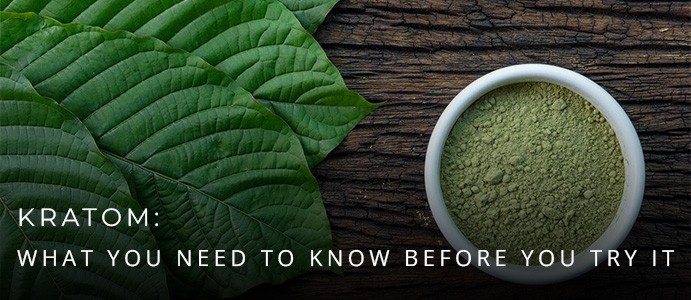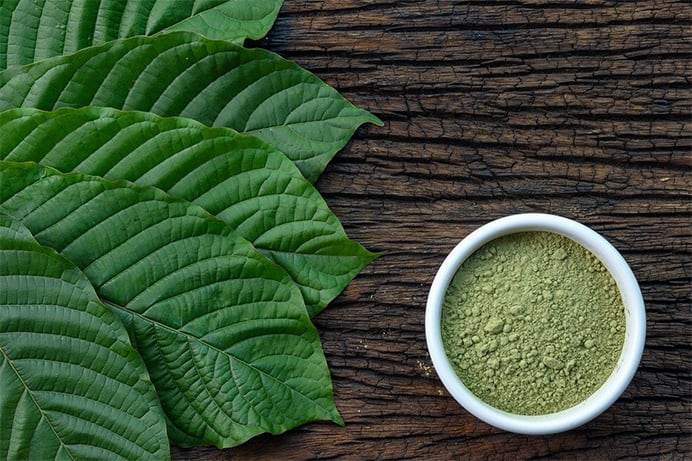
Kratom – What is it?
Kratom, also known as Mitragyna speciosa, is a tropical evergreen tree native to Southeast Asia. It belongs to the coffee family, Rubiaceae, and is indigenous to Thailand, Indonesia, Malaysia, Myanmar, and Papua New Guinea. The leaves of the kratom tree have been used traditionally by local cultures for their medicinal properties.

Kratom leaves contain a variety of alkaloids, with the most prominent ones being mitragynine and 7-Hydroxymitragynine. These alkaloids interact with the body’s opioid receptors but distinctly and uniquely, setting kratom apart from classical opioids. Its effects vary depending on the dosage, with lower doses providing a stimulant effect and higher doses inducing a sedative effect.
Despite its long history of traditional use in Southeast Asia, kratom is a relatively new arrival in the Western world. It has attracted attention for its potential therapeutic uses, as well as concerns related to safety, dependency, and regulation.
Kratom 101: Introductory Info
Kratom’s effects are largely due to its interaction with the mu-opioid receptors in the brain. However, unlike traditional opioids that typically provide purely sedative effects, kratom’s impact varies with the dosage. In smaller amounts, it has an alerting and energizing effect similar to caffeine. At higher doses, it provides a more sedative, pain-relieving effect, reminiscent of classical opioids but without the same risk profile.
What makes kratom unique and a subject of interest is its atypical interaction with opioid receptors. The alkaloids in kratom, notably mitragynine and 7-Hydroxymitragynine, do not recruit beta-arrestin upon binding to the receptors. Beta-arrestin recruitment is a crucial mechanism implicated in the most dangerous side effects of opioids, including respiratory depression and tolerance development.
Furthermore, kratom also contains alkaloids that act as mu-opioid antagonists and NMDA antagonists, both known for their role in preventing tolerance development to mu-opioid agonists. This complex and unique pharmacological profile positions kratom as an intriguing substance for scientific research and potential therapeutic use.
How does Kratom work in the brain?
The primary active compounds in kratom, mitragynine and 7-Hydroxymitragynine, exert their effects on the nervous system by interacting with the body’s opioid receptors. While the term “opioid” often conjures thoughts of substances like morphine or heroin, it’s important to understand that our bodies naturally have opioid receptors and endogenous opioids, such as endorphins, which are involved in pain relief and reward mechanisms.

Mitragynine and 7-Hydroxymitragynine have a complex mode of action. They primarily act as agonists at the mu-opioid receptors, which means they bind to these receptors and stimulate them, leading to analgesic (pain-relieving) and euphoric effects. However, unlike traditional opioids, these compounds also act as antagonists at the delta-opioid receptors. This dual activity contributes to the unique profile of effects observed with kratom.
Perhaps most notably, these alkaloids do not recruit beta-arrestin, a protein usually involved in the signalling of opioid receptors. This is significant as the recruitment of beta-arrestin is associated with many of the adverse effects of traditional opioids, including respiratory depression, tolerance, and dependence. The lack of beta-arrestin recruitment by kratom’s alkaloids may potentially contribute to a safer profile for the substance.
Additionally, other alkaloids present in kratom are mu-opioid antagonists and NMDA antagonists, compounds known to help prevent the development of tolerance to mu-opioid agonists.
Types of Kratom
There are several different types, or strains, of kratom, which are generally classified by the colour of the veins in the leaves. The three most common types are Red Vein, Green Vein, and White Vein:
- Red Vein Kratom: Known for its calming and soothing properties, red vein kratom is often used for relaxation and pain relief. It is considered the most popular and widely available strain of kratom.
- Green Vein Kratom: Green vein kratom is known for providing a balance between the stimulating effects of the white vein and the pain-relieving effects of the red vein. Users often report improved focus and energy with this strain.
- White Vein Kratom: Often used for its energizing and mood-enhancing effects, white vein kratom is ideal for those seeking a stimulant-like effect.
There’s also Yellow Vein Kratom, which is not a naturally occurring variety but rather a blend of other types, often fermented for a longer period, leading to distinct properties.
While these are general guidelines, it’s important to note that the effects of any given type of kratom can vary based on a variety of factors, including the specific strain, the individual’s body chemistry, the dosage used, and the method of consumption. Thus, personal experiences with kratom can vary widely.
Where to Buy Kratom
Due to the increasing popularity of Kratom, it can be found in several places both online and offline. However, it’s essential to buy Kratom from reputable sources to ensure the product’s quality and safety.
- Online Stores: These are often the best places to find high-quality Kratom. Reputable online vendors typically offer a wide variety of strains and undergo rigorous testing to ensure the quality of their products. Some online vendors also provide detailed descriptions of each strain’s effects to help you make an informed decision.
- Physical Stores: Kratom can also be purchased at local smoke shops, head shops, and some health food stores. While buying from a physical store allows you to get the product immediately, the selection might be limited, and the quality can vary significantly.
- Directly from Growers: If possible, buying directly from growers or cooperatives can be a good way to ensure the product’s quality and authenticity. This option might be limited due to geographical constraints and access to growers.
Things to Consider when Choosing a Kratom Vendor
- Lab Testing: The vendor should have their products tested for quality, consistency, and contamination. This ensures that you’re buying a safe, potent product.
- Transparency: The vendor should provide information about where they source their Kratom, how it’s harvested, and what processes it undergoes before reaching you.
- Variety: A good vendor should offer a wide variety of strains to cater to different preferences and needs.
- Customer Service: The vendor should have a responsive, helpful customer service team. They should be able to answer your questions about the product and the buying process.
- Reviews: Check reviews from other customers. They can provide invaluable insight into the product’s quality and the vendor’s reliability.
Remember, buying Kratom from a reputable source is vital. Always research and review vendors before making a purchase.
How does Kratom Feel?
The effects of Kratom are highly variable and depend on factors such as strain, dosage, individual physiology, and the method of consumption. Generally, at lower doses, Kratom can produce stimulating effects, akin to caffeine. Users report increased alertness, sociability, and energy.
At higher doses, Kratom can have more sedating effects. It can bring feelings of calm, euphoria, and pain relief. Some people use Kratom for its potential to ease symptoms of opiate withdrawal, although this use is not scientifically validated and can carry risks.
It’s important to note that each individual’s experience with Kratom can vary significantly. Factors like tolerance, body weight, metabolism, and personal sensitivity can all influence how Kratom feels.
Kratom Recommended Dosage
Kratom dosage depends on a multitude of factors, including strain, individual tolerance, body weight, and desired effects. As such, it’s difficult to establish a universal dosage guideline. However, for beginners, it’s generally recommended to start low and gradually increase until desired effects are achieved.
Here’s a basic guideline for Kratom dosage:
- Threshold Dose (1-2 grams): This is the smallest amount that typically produces effects. For first-time users, this is a good starting point.
- Light Dose (2-4 grams): A light dose can produce subtle stimulating and mood-enhancing effects.
- Moderate Dose (4-6 grams): A moderate dose can produce a balance of stimulating and sedating effects. This dose is often used for pain relief.
- High Dose (6-8 grams): High doses are more likely to produce sedating and euphoric effects. They’re also more likely to produce side effects, especially in individuals with no Kratom tolerance.
- Very High Dose (8+ grams): Very high doses can lead to strong sedative effects and a higher risk of side effects and dependency. These doses should be avoided by inexperienced users.
It’s crucial to remember that this is a general guide and individual responses can vary greatly. It’s best to start with a low dose and gradually increase it while monitoring your body’s response. Always consult with a healthcare professional if you’re unsure.
Kratom Benefits
Kratom has been used traditionally for centuries in Southeast Asia for its medicinal properties. Some modern users around the world have reported that kratom may provide benefits, such as:
- Pain relief: Some strains of kratom, particularly the red ones, may have analgesic properties and may be used to manage chronic pain. However, more research is needed to confirm these effects.
- Improved mood: Kratom may have mood-lifting effects, potentially helping with symptoms of depression and anxiety. However, more research is needed to confirm these effects.
- Energy boost: Lower doses of kratom, especially white and green strains, may boost energy levels and increase focus, similar to caffeine. However, more research is needed to confirm these effects.
- Ease opiate withdrawal: Some individuals report using kratom to ease withdrawal symptoms from opiate addictions. However, this use is not medically recommended and can carry risks.
- Improved sleep: Higher doses of certain strains of kratom may aid sleep and help with conditions like insomnia. However, more research is needed to confirm these effects.
It is important to note that kratom is a relatively new substance in the Western world, and there is still much that we do not know about its safety and efficacy. If you are considering using kratom, it is important to do your research and talk to your doctor to make sure that it is right for you.
Kratom Clinical Research
While the full range of kratom’s effects is yet to be fully understood, current scientific research has shown some potential benefits:
- Kratom helps control pain. A study published in 2019 suggested that two compounds in kratom—mitragynine and 7-α-Hydroxymitragynine—interact with opioid receptors in the brain, which may produce sedation, pleasure, and pain relief.
- Kratom as an antidepressant. Research has indicated that kratom might have potential as an antidepressant and anxiolytic substance, though more extensive studies are required to confirm these effects.
- Kratom for withdrawal from opiate addiction. Some research supports the use of kratom as a tool to aid withdrawal from opiate dependencies. It seems to work on the same receptors as opiates, potentially alleviating withdrawal symptoms, but without producing the same dangerous side effects. However, this use should be approached with caution, and ideally under the supervision of a healthcare professional, due to the potential for developing a dependency on kratom itself.
It is important to note that kratom is not a regulated drug, and the quality and safety of kratom products can vary widely. It is also important to note that kratom can interact with other medications, so it is important to talk to your doctor before using kratom.
Kratom LD50
The LD50 (lethal dose for 50% of the population) of Kratom is not definitively established due to the lack of controlled human studies, and it is challenging to accurately determine due to the wide variability in alkaloid concentration between different strains and even within the same strain. However, according to a study published in 2018, the estimated lethal dosage of Kratom’s primary alkaloid mitragynine in humans is about 2.6 grams or more. This would equate to a dosage of roughly 1000 grams (or 1 kilogram) of Kratom leaves consumed at once, which is practically unachievable. Nonetheless, these estimates are rough and further research is needed to confirm them. High doses can lead to uncomfortable and potentially dangerous side effects, so responsible usage is crucial.
Hepatotoxicity – Rare But Serious Genetic Condition
In rare cases, Kratom usage has been associated with hepatotoxicity, a form of liver damage characterized by the destruction of cells in the liver. The majority of these cases have been reported in individuals with a specific genetic condition that affects the body’s ability to process the alkaloids found in Kratom. This leads to a buildup of these substances in the liver, causing cell death and potentially severe liver damage. However, it should be noted that this condition is extremely rare and has been reported in a small fraction of users. Most people can use Kratom without this risk, but if you notice symptoms such as jaundice, itching, dark urine, stomach pain, and light-coloured stools, stop use immediately and seek medical attention.
Kratom Side Effects
While many users report that Kratom helps manage pain, enhancing mood, and other benefits, it’s important to note that there can also be side effects. These effects can vary widely from person to person and are largely dose-dependent. Lower doses are more stimulating while higher doses tend to be more sedative.
Common side effects at higher doses may include dry mouth, loss of appetite, chills, nausea and vomiting, changes in urination, constipation, and dizziness. Some users have also reported experiencing anxiety or agitation, itching, sweating, and raised blood pressure.
In rare cases, prolonged heavy use can lead to a condition known as hyperpigmentation, or darkening of the skin. Long-term use may also result in weight loss, insomnia, and a range of other health issues.
Dependency vs. Addiction
It’s crucial to distinguish between physical dependency and addiction when discussing Kratom use.
Dependency is a physical state where the body has adapted to the presence of a substance, in this case, Kratom. If a dependent individual abruptly stops using the substance, they will experience withdrawal symptoms. This is a normal physiological response and can occur with many substances, from caffeine to more potent drugs.
Addiction, on the other hand, is characterized by the inability to stop using a substance despite negative consequences to one’s health, relationships, or responsibilities. It involves compulsive use and often involves a psychological component, where the individual may crave the substance.
With Kratom, as with any substance, it’s possible to become physically dependent or addicted. The risk is believed to increase with higher doses and longer-term use. Individuals who use Kratom to manage a health condition should do so under the guidance of a healthcare provider and be mindful of the potential for dependency and addiction. It’s important to be aware of these risks and to use Kratom responsibly, and in moderation.
Understanding the Risks
Despite the reported benefits of Kratom, it is not without risks. Misuse of Kratom can lead to adverse outcomes. Excessive consumption can lead to serious health issues including severe nausea, vomiting, loss of appetite leading to dangerous weight loss, cardiovascular issues (raised heart rate and blood pressure), liver damage, and seizures. The risk of these side effects increases with higher doses.
Additionally, mixing Kratom with other substances, especially opioids, alcohol, and sedatives, can lead to dangerous interactions. This combination can exacerbate respiratory depression, potentially leading to a fatal outcome.
Furthermore, a risk of dependency or addiction exists with long-term use of Kratom, as discussed previously. This can lead to withdrawal symptoms upon cessation, including muscle aches, irritability, mood disturbances, insomnia, and aggression.
Finally, the lack of regulation and standardization in the Kratom market poses risks. There’s a possibility of product adulteration or contamination, leading to increased health risks.
Reducing or Stopping Use of Kratom – Overview
Whether due to dependency or a personal choice, if an individual decides to reduce or cease their Kratom use, it’s important to do so responsibly.
For those who have been using Kratom for a long time, or in high doses, it’s typically recommended to gradually taper the dose down rather than stopping abruptly. This allows the body to adjust slowly, which can minimize withdrawal symptoms. This process, known as tapering, can be done over weeks or months, depending on the individual’s usage pattern.
Symptoms of Kratom withdrawal can include irritability, anxiety, restlessness, sleep disturbance, and physical discomfort. These symptoms can be managed with the support of a healthcare provider.
Several resources exist for individuals wishing to reduce or stop their Kratom use, including online communities that offer support and advice. As always, consulting with a healthcare provider is recommended when making changes to one’s Kratom use.
Kratom Legality
United States
In the United States, kratom is not federally regulated. Its legal status is largely dependent on state and local laws. Some states, including Alabama, Arkansas, Indiana, Rhode Island, Vermont, and Wisconsin, have classified kratom as a controlled substance, making it illegal to sell, possess, or use. On the other hand, in states like California, Illinois, and New York, kratom is legal to buy and use for anyone over the age of 18 or 21 depending on the state.
Australia

In Australia, kratom is considered illegal. The Australian government banned the use of kratom in 2003 due to its potential for abuse as a narcotic substance, and it was fully criminalized in 2005. It is illegal to purchase, possess, supply, distribute, manufacture, or produce kratom across all states and territories in Australia. Kratom is classified as a Schedule 9 substance according to the Australian Drug and Poisons Schedule Committee, meaning it is considered a narcotic drug. Penalties for using or possessing kratom can range from 12 months to two years imprisonment and/or a $2,200 fine.
United Kingdom
Kratom is currently legal in the United Kingdom. However, as of 2021, it is included in the Psychoactive Substances Act, which means it is illegal to produce, supply, or import this drug for human consumption. However, it is not illegal to possess kratom in the UK.
More Countries
Kratom’s legal status varies significantly around the world. In some countries, it’s entirely legal, in some it’s regulated, and in others, it’s outright illegal. Here are a few examples:
- In Canada, kratom is classified as a natural health product and is legal to purchase without a prescription.
- In Germany, kratom is not a controlled substance, but it’s also not approved for consumption. This means it can be purchased and owned, but not legally ingested.
- In Malaysia, kratom (or Ketum as it’s known locally) is illegal to cultivate but legal to consume.
- In Thailand, where the plant is native, kratom was illegal for many years but was decriminalized in 2018, and fully legalized for medical use in 2021.
This list is not exhaustive, and laws can change rapidly, so it’s essential to check with local regulations if you’re unsure about the legality of kratom in your area. It’s also important to note that even in places where kratom is legal, there may be restrictions on its sale, production, or use.
Keeping Kratom Legal
Kratom advocates argue that keeping kratom legal supports a safer alternative for individuals seeking relief from various ailments, as it presents fewer risks than certain prescription medications. Supporters also maintain that prohibition is counterproductive and could potentially lead to an unsafe, unregulated black market. Advocacy groups like the American Kratom Association (AKA) work to protect consumer access to kratom, arguing for reasonable regulation instead of outright bans. They also push for compliance with existing dietary supplement regulations and good manufacturing practices to ensure the quality and safety of kratom products.
Botanical Supplement vs. Drug
One of the main issues in the kratom debate is whether it should be classified as a botanical supplement or a drug. This distinction impacts how it’s regulated and who can access it.
As a botanical supplement, kratom can be sold without the rigorous testing and regulatory oversight that drugs require. This allows for easier access for consumers but also increases risks related to inconsistent product quality and misleading marketing.
If kratom were classified as a drug, it would need to undergo rigorous testing for safety and efficacy before being marketed. This process can take several years and cost millions of dollars, potentially limiting access for individuals who rely on kratom. It would also mean that kratom could be prescribed by a doctor and potentially covered by insurance.
The Opioid Label Problem
Kratom is often mislabeled as an opioid due to its interaction with opioid receptors in the brain. However, this label is a source of controversy. While kratom does interact with the same receptors as opioids, it does so in a different way, resulting in milder effects compared to typical opioids.
Many argue that labelling kratom as an opioid is misleading and could contribute to unjustified fears and stigma, potentially leading to unnecessary regulation or outright bans. Despite these concerns, the U.S. Food and Drug Administration (FDA) maintains that kratom is indeed an opioid because of its effect on the brain’s opioid receptors.
This labelling issue underscores the complexities of kratom regulation. While the plant has psychoactive effects, the extent and nature of these effects are still being studied, and the implications for regulation are not yet clear.

Leave a Reply